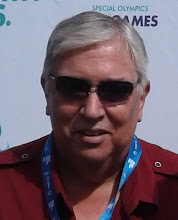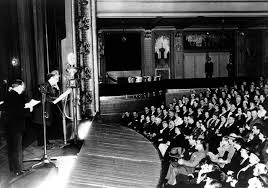Two Farewells: The Way It Was, 26 December
Two longtime old-time radio favourites air for the final times, in successive years . . .
1953---The Glens Falls Town Hall tower clock strikes for the final time as Big Sister, a CBS daytime mainstay since 1936, airs its final episode today, with Grace Matthews (the fifth to play the role) in the title role of self-sacrificing Ruth Evans Wayne and Fran Carden (the fourth to play the role) as younger sister Susan Evans Miller, one of several orphaned siblings for whom Ruth has cared before and after her own marriage.
ANNOUNCER: Rinso presents . . . Big Sister.
SFX: (Tower clock begins to strike)
ANNOUNCER: Yes, there's the clock in Glens Falls Town Hall, telling us it's time for Rinso's story of Big Sister.---The show's standard introduction.
Alice Frost originated the title role in 1936, with Haila Stoddard as the original Sue. The other three actresses who played Ruth were Nancy Marshall, Marjorie Anderson, and Mercedes McCambridge; the other two who played Sue were Dorothy McGuire and Peggy Conklin.
The show was created by Lillian Lauferty and written by Julian Funt, Robert Newman, Carl Bixby, and Bill Sweets and sponsored for most of its life by Rinso detergents. It also had the distinction of becoming one of the radio soaps analysed academically enough, by University of Chicago researchers W. Lloyd Warner and William E. Henry, even if CBS instigated the project in a bid to determine just what kind of listener was listening in to the show.
The Big Sister program arouses normal and adaptive anxiety in the women who listen. [It] directly and indirectly condemns neurotic and non-adaptive anxiety and thereby functions to curb such feelings in its audience. This program provides moral beliefs, values, and techniques for solving emotional and interpersonal problems for its audience and makes them feel they are learning while they listen . . . It directs the private reveries and fantasies of the listeners into socially approved channels of action. [It] increases the women's sense of security in a world they feel is often threatening, by reaffirming the basic security of the marriage ties (John's and Ruth's); by accentuating the basic security of the position of the husband (Dr. John Wayne is a successful physician); by "demonstrating" that those who behave properly and stay away from wrong-doing exercise moral control over those who do not; and, by showing that wrong behaviour is punished . . . The women aspire to, and measure themselves by identification with Ruth, the heroine; however, the identification is not with Ruth alone, but with the whole program and the other characters in the plot. This permits sublimated impulse satisfaction by the listeners, first, unconsciously identifying with the bad woman and, later, consciously punishing her through the action of the plot. Unregulated impulse life is condemned, since it is always connected with characters who are condemned and never related to those who are approved.---Warner and Henry, cited by James Thurber, in "Soapland: The Listening Women," The New Yorker, 1947-48; republished in The Beast in Me and Other Animals. (New York: Harcourt, Brace and Company, 1948.)[Newman and Funt] have made [Big Sister] one of the most popular of all serials. For more than two years, it has dealt with a moony triangle of Ruth Wayne, the big sister of the title, her estranged husband, Dr. John Wayne, and another doctor named Reed Bannister. The authors, I am told, plan to tinker with the popular old central situation, but they are aware that they must proceed with caution. The identifiers are strongly attached to the status quo of plot situation, and to what psychologists call the "symbols" in soap opera---serial authors call them "gimmicks"---and they do not want them tampered with. Thus, the soap opera males who go blind or lose the use of both legs or wander around in amnesia are, as the psychologists put it, symbols that the listening women demand. As long as the symbols are kept in the proper balance and the woman is in charge and the man is under her control, it does not seem to make a great deal of difference to the female listeners whether the story is good or not.---Thurber.
Presumably, we may leave it to those who listened to determine whether Dr. John Wayne merely got his, when he was killed in a plane crash late in the serial's run.
Several old-time radio mainstays appeared on Big Sister at various times during its run, including Teddy Bergman (a stage alias for Fred Allen Show mainstay Alan Reed, as Asa Griffin); future mr. ace and JANE castmates Evelyn Varden (as Mrs. Carvell) and Eric Dressler (as Frank Wayne); Boston Blackie star Richard Kollmar (as Michael West); future Richard Diamond, Private Detective co-star Ed Begley (as Waldo Briggs and Charles Daniels); Pepper Young's Family star Mason Adams (as Dr. Marlowe); and, future game and talk panelist Arlene Francis (as Lola Mitchell), among others.
1954: CRIME DOES NOT PAY ANY LONGER---Not for The Shadow, whose radio life began in 1932 but ends today, with Bret Morrison in the title role he's played for a decade, succeeding (in ascending order) Robert Hardy Andrews, Orson Welles, and Bill Johnstone.
The final cast includes Lesley Woods as the fifth Margot Lane (succeeding, in ascending order, Agnes Moorehead, Marjorie Anderson, Gertrude Warner, and Grace Matthews); Ted de Corsia as the sixth Commissioner Weston (succeeding, in ascending order, Dwight West, Arthur Vinton, Kenny Delmar, Santos Ortega, and Jimmy La Curto); and, Mandel Kramer as the third Shrevie (succeeding, in ascending order, Keenan Wynn [the son of comedy legend Ed Wynn] and Alan Reed).
Andrews, the original Lamont Cranston/Shadow, led one of the more interesting of double lives at the time he originated the role: he was a former journalist who became one of the most prolific radio soap writers in the business, especially for Frank and Anne Hummert---including for Ma Perkins and Jack Armstrong, All-American Boy (which he created), before making a distinguished career as a screenwriter and short story author.
CHANNEL SURFING . . .
1948: BERLIN, 1945---In a repeat of a December 1947 broadcast, five American soldiers still in Berlin following the war's end invite a mysterious stranger (Ernest Chappell) to join them for their Christmas dinner, on tonight's edition of Quiet, Please. (Mutual.)
Additional cast: Inaudible. Writer: Wyllis Cooper.
1949: THE CHRISTMAS PRESENT---It's from sponsor Scott (Gale Gordon), and it's got Phil (Harris) and Alice (Faye) in a stir because they've mistaken it for something else with potentially fateful results, on tonight's edition of The Phil Harris-Alice Faye Show. (NBC.)
Remley: Elliott Lewis. Little Alice: Jeanine Roos. Phyllis: Anne Whitfield. Willie: Robert North. Julius: Walter Tetley. Music: Walter Sharp, Phil Harris Orchestra. Writers: Ray Singer, Dick Chevillat.
1951: SWEET SORROW (A.K.A. DRAMATIC CLUB TRYOUTS)---It's almost sour grapes before the Halls (Ronald and Benita Colman) can slog through the annual drama tryouts . . . and the annual pressures to play favourites and roles in the show, on tonight's edition of The Halls of Ivy. (NBC; rebroadcast: Armed Forces Radio Service.)
Wellman: Herbert Butterfield. Additional cast: Unknown. Announcer: Ken Carpenter. Writer: Don Quinn.
PREMIERING TODAY . . .
1891---Tony Wons (host: The Tony Wons Scrapbook; The House By the Side of the Road; The Camel Quarter Hour), Menasha, Wisconsin.
1893---Vladimir Golschmann (conductor: The New York Philharmonic), Paris.
1902---Irene Handl (actress: Hello, Playmates), London.
1914---Richard Widmark (actor: Home of the Brave; Joyce Jordan, M.D.), Sunrise, Minnesota.
1921---Steve Allen (comedian/composer/actor: Smile Time; The Steve Allen Show), New York City.
1893---Vladimir Golschmann (conductor: The New York Philharmonic), Paris.
1902---Irene Handl (actress: Hello, Playmates), London.
1914---Richard Widmark (actor: Home of the Brave; Joyce Jordan, M.D.), Sunrise, Minnesota.
1921---Steve Allen (comedian/composer/actor: Smile Time; The Steve Allen Show), New York City.












0 Comments:
Post a Comment
Subscribe to Post Comments [Atom]
<< Home